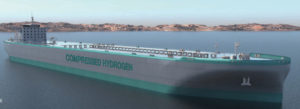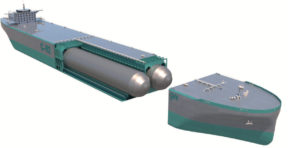GEV’s hydrogen-powered hydrogen ship is on track with a scoping study in progress
Energy
Energy
A scoping study is progressing for Global Energy Ventures’ (ASX:GEV) world’s first ship for transporting hydrogen exports from Australia.
The ship’s innovative design will enable the C-H2 ship to carry compressed hydrogen, the zero-carbon fuel of the future, to customers in Asian markets.
“The C-H2 ship design is the culmination of significant engineering work by our team with the support of Capilano naval architects,” executive director, Martin Carolan, said.
Several Asian countries are developing hydrogen-based industries including for power generation as they strive to decarbonise their economies.
“Today’s launch of the C-H2 specification will support our entry into the marine transport of hydrogen and play a role in the development of a global hydrogen economy,” he said.
The C-H2 ship will be the first of its kind to carry compressed hydrogen exports and its design addresses specific aspects of hydrogen storage.

The scoping study is for the technical and economic aspects of the C-H2’s compressed hydrogen cargo compared with other transport methods for hydrogen such as liquefaction or an ammonia product.
The study will also address the C-H2 ship’s hydrogen supply chain and the technical measures needed to export annualised volumes of 50,000 to 400,000 tonnes per year of hydrogen to various markets such as Korea, Japan and Singapore from Australia.
“The application of compression, an existing solution for the storage and transport of hydrogen, with the company’s proprietary C-H2 ship design, will have the advantages of simplicity in the development and implementation to compress/load, transport and unload,” said Carolan.
A specification and general arrangement drawing for the 2,000-tonne capacity ship has been completed by Capilano Maritime Design.
And, a patent application for the apparatus used for the on-board storage of hydrogen on the C-H2 ship has been filed with US patent authorities.
The patent application is intended to protect the significant intellectual property that the company has developed to date in marine compressed gas vessels.
Global Energy Ventures is in talks with the American Bureau of Shipping to achieve approval in principle for the C-H2 ship, which is expected in mid-2021.
The approval in principle stage will mean the C-H2 ship can move ahead from its design stage to its construction phase.
The company’s propriety design for its C-H2 ship comprises two 20-metre diameter tanks within the hull that will store ambient temperature hydrogen at an operating pressure of 3,600 psi.
The ship’s design allows for the construction of smaller capacity ships to carry compressed hydrogen exports for demonstration and pilot purposes.
A key aspect of the C-H2 ship’s design is a special liner inside each of the storage tanks that prevents hydrogen from escaping into the steel structure of the ship.
Hydrogen molecules can enter steel structures and weaken them over time unless protection is used to prevent their migration.
Another technical aspect of the C-H2 ship is that its storage tanks need to be constructed in layers.
An inner-most layer of steel resistant to hydrogen embrittlement is required followed by six more layers of ductile, high strength alloy steel to meet strength and fatigue standards.
An advantage of this type of steel structure is that should any layer suffer cracks they will not travel to adjacent layers in the storage tanks.

GEV intends for its C-H2 ship to run on hydrogen instead of oil-based bunker fuel thereby providing a zero-carbon shipping solution for the vessel.
The company is aiming for a target date of the first half of 2022 to complete all of the approvals for the C-H2 ship.
Some recent test shipments of hydrogen from the LaTrobe H2 project in Victoria are the only export cargoes to date to leave Australia and are destined for Japan.
Australia is one of the world leaders in developing a hydrogen exports sector, and a National Hydrogen Strategy is being steered by the CSIRO, supported by $500m of funding.
“Only last month, the government announced $1.9bn of investment in clean energy technologies over the next 10 years with hydrogen the number one of five technologies to be advanced,” Carolan told Stockhead in October.
The aim of the National Hydrogen Strategy is to develop a national hydrogen industry for domestic and export uses capable of producing the fuel at under $2 per kilogram in 2030.